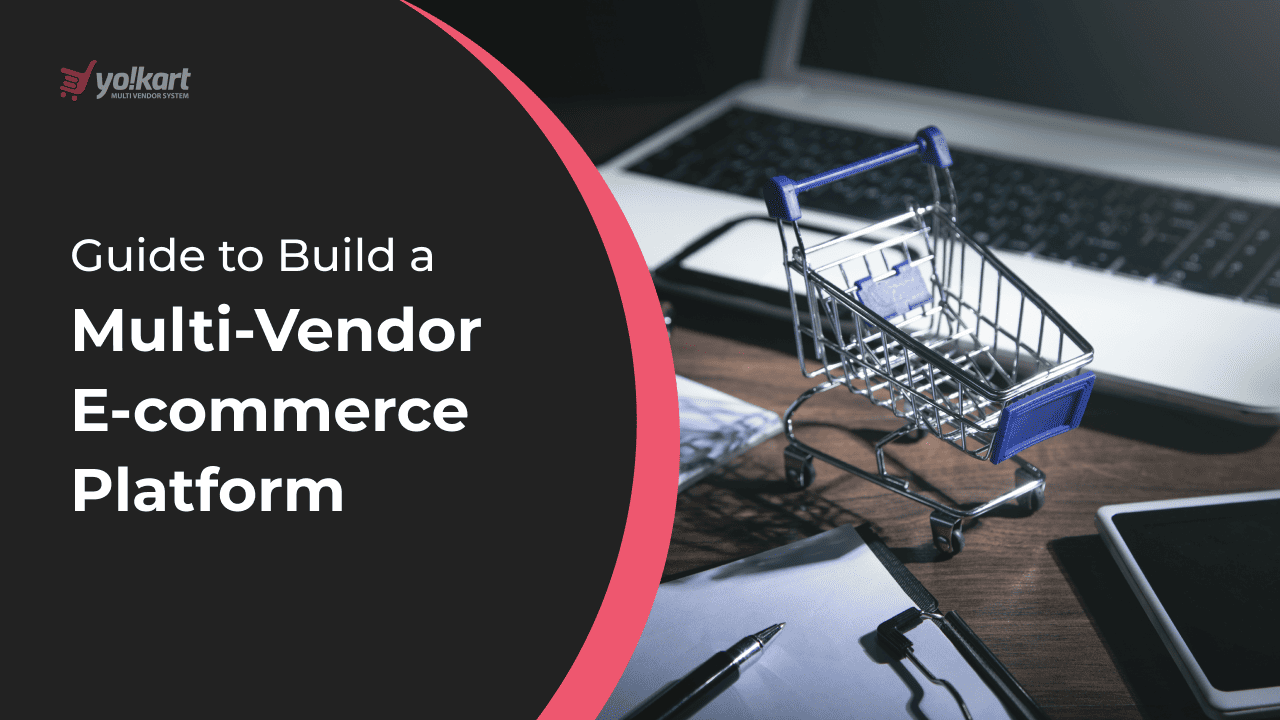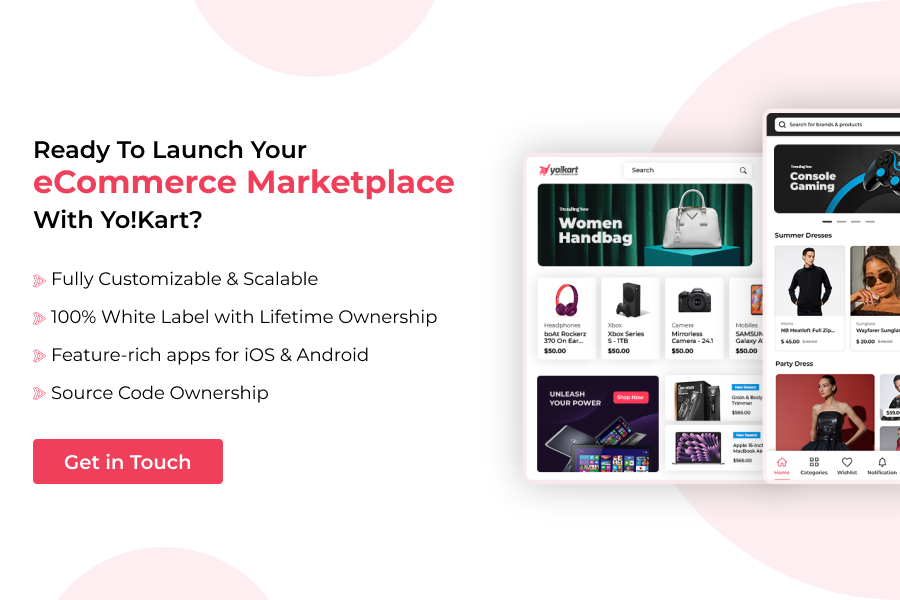With the increasing reliance on digital marketplaces, businesses are continuously exploring innovative ways in order to connect with a wider audience and scale. One such proven model is a multi-vendor platform. These platforms are a unified space where multiple sellers converge to offer their products or services to a shared customer base. According to Global View Research, the global multi-vendor support services market is projected to reach $73.19 billion by 2030. These multi-vendor platforms for startups, from e-commerce giants to niche marketplaces, have disrupted the traditional business models and empowered entrepreneurs to compete in this dynamic, globalized market.
The potential of multi-vendor platforms for startups is immense and offers a strategic leap toward creating an inclusive, scalable ecosystem that benefits both sellers as well as buyers. A research states that $8.7 trillion of sales are forecasted by the beginning of 2025. However, the major concern is how entrepreneurs can ensure that their multi-vendor platforms stand out amidst the competition and what critical steps they need to focus on to turn their vision into reality.
This comprehensive will cover the nuances of multi-vendor platforms; from their definition and benefits to the essential steps required to build one that best aligns with your business requirements.
Table Of Contents
- What is a Multi-Vendor E-commerce Platform?
- Types of Multi-Vendor E-commerce Platforms
- Benefits of Launching a Multi-Vendor E-Commerce Platform
- How Does a Multi-Vendor E-commerce Platform Work?
- Essential Features of a Multi-Vendor E-commerce Platform
- Steps to Build a Multi-Vendor E-commerce Platform for Startups
- Our Recommendation
- Wrapping Up
- FAQs
What is a Multi-Vendor E-commerce Platform?
A multi-vendor e-commerce platform is a digital marketplace that allows multiple sellers to list and sell their products or services on a single platform. Multi-vendor platforms enable buyers to browse and purchase products/services from various sources. Thus, offering a more centralized space. Here are the names of some of the popular multi-vendor e-commerce platforms that you can take reference from:
- Amazon
- eBay
- Etsy
- Alibaba
- AliExpress
- Walmart
- Flipkart
- Shopee
- Target
- Best Buy
Unlike single-vendor platforms, where only a single seller offers products or services, a multi-vendor platform hosts numerous sellers—each offering unique products or services. Thus, creating a competitive environment. According to a research, 57% of net online sales are done through a multi-vendor platform worldwide.
Businesses benefit with an access to a large customer base, as multi-vendor platforms bring together a variety of customers under one single platform. Apart from this, these platforms additionally offer tools for businesses to manage their product catalog, process orders and handle logistics. This makes it easier to scale operations.
Types of Multi-Vendor E-commerce Platforms
Categorized by their offerings and target audience, multi-vendor e-commerce platforms provide businesses with versatile solutions to engage customers, expand reach and drive growth.
Based on Offerings:
1. Product-based Platforms: These platforms primarily focus on physical goods, offering a range of products from various vendors. Popular examples include Amazon, eBay, Etsy, Walmart, etc.
2. Service-based Platforms: Through these platforms, vendors offer various services such as freelancing, bookings, consultation and more. Popular platforms are: Fiverr, Upwork, TaskRabbit, Thumbtack and more.
3. Hybrid Platforms: These platforms offer a broader selection to customers, offering a combination of products and services both. For Instance, Amazon, Sephora, etc.
Based on Audience:
1. Business-to-Business (B2B) Platforms: These platforms facilitate transactions between businesses. This allows vendors to sell their products or services to other businesses. Example: Alibaba, Amazon Business, ThomasNet, IndiaMart.
2. Business-to-Consumer (B2C) Platforms: B2C platforms connect multiple vendors with end consumers, focusing on delivering a broad range of products or services to individual buyers. For Instance, Amazon, eBay, Etsy, Walmart and Target.
3. Consumer-to-Consumer (C2C) Platforms: These platforms enable individuals to sell directly to other individuals, typically for second-hand goods or peer-to-peer services. Popular Platforms include eBay, Craigslist, Poshmark, Depop and more.
These distinctions help tailor the platform’s design, user experience and functionality to best suit the needs of vendors and their target audience.
Curious to Build Your Own Multi-Vendor E-Commerce Platform?
Benefits of Launching a Multi-Vendor E-Commerce Platform
Building a multi-vendor e-commerce platform for startups extends a suite of benefits, which are as follows:
1. Zero-Inventory Business Model
Multi-vendor e-commerce platforms operate without the need to maintain any inventory. This significantly reduces capital investment and storage costs. Such platforms act as an intermediary that connects vendors and buyers directly. Thus, minimizing overhead costs, focusing on streamlining transactions and user experience.
2. Global Reach
Multi-vendor platforms break geographical barriers, allowing businesses to connect with a worldwide audience. Vendors can tap into diverse markets, which ultimately helps in expanding customer bases and enhancing sales potential. This global accessibility fosters cross-border trade and drives growth for all stakeholders.
3. Low Operational Costs
The operational costs for platform owners are substantially reduced with vendors handling inventory and logistics. Multi-vendor e-commerce platforms leverage advanced technology to automate processes such as order management, payment handling and customer support. Thus, ensuring cost efficiency and scalability.
4. Increased Revenue Streams
One notable advantage of a multi-vendor e-commerce platform is that it unlocks multiple revenue streams through commissions, subscriptions, advertisements and more. This diversified approach ensures consistent income while providing flexibility to optimize and innovate monetization strategies.
5. Reduced Risk
Multi-vendor e-commerce platforms mitigate risks associated with market fluctuations and unsold stock by diversifying vendor offerings and eliminating inventory liabilities. This shared responsibility model fosters stability and adaptability. Thus, ensuring long-term stability for the business.
How Does a Multi-Vendor E-commerce Platform Work?
A multi-vendor e-commerce platform consists of three primary stakeholders that work collaboratively in order to provide a unified experience, which are as follows:
- Vendor/Seller: The seller who registers on the platform to sell goods or services.
- Buyer: The customer who explores the platform to buy any goods or services.
- Admin: The marketplace owner who keeps track of all the actions.
Here’s how the ecosystem works:
Step 1: Firstly, vendors register on the platform by creating their profiles and listing their products or services with detailed descriptions, prices and images.
Step 2: The platform blends all vendor offerings into a centralized marketplace, enabling customers to browse, search and compare products.
Step 3: Customers explore the platform, add items to their cart and proceed to checkout after selecting the desired products or services.
Step 4: The platform processes orders and forwards them to the respective vendors, who then prepare and fulfill the orders.
Step 5: The delivery of the products is coordinated through integrated logistics or vendor-managed systems. Apart from this, the platform then manages the payments, dividing them between all the stakeholders.
Step 6: Customers leave reviews & ratings on the platform.
Step 7: In case of any issue, vendors or the platform provide customer support, handle returns and manage payments to build credibility.
Revenue Generation Model
In order to ensure consistent income flow and maximize profitability, a multi-vendor platform offers multiple revenue generation schemes. Understanding these revenue channels is beneficial for your platform’s growth.
Below are some of the dominant revenue streams:
- Commission Per Order
- Third-Party Advertising
- Subscription Offers
- Strategic Partnerships
- On-demand Specialized Services
- Featured Product Listings
Maximize Business Profitability with a Robust Multi-Vendor Platform
Essential Features of a Multi-Vendor E-commerce Platform
A robust multi-vendor platform must cater to the needs of both vendor and admin while ensuring a seamless experience for customers. Below, we outline the essential features required for a successful platform:
From Vendor Perspective:
1. Individual Seller Storefronts: Vendors should have their own dedicated storefronts to showcase their products and establish their brand identity.
2. Real-Time Inventory Updates: This feature ensures that vendors can update the stock levels immediately in order to reduce the chances of overselling.
3. Bulk Purchasing: Allow vendors to manage bulk orders efficiently by enabling tiered pricing and bulk purchase discounts to attract manufacturers or businesses as well.
4. RFQ Module: A Request-for-Quote (RFQ) module empowers vendors to interact directly with buyers for customized orders or special pricing agreements, which is particularly beneficial in B2B multi-vendor platforms.
5. Order Management: This feature is crucial for tracking, processing and fulfilling orders promptly.
6. Track Earnings: Allow vendors to track their earnings in real time, including reports on sales, refunds and commissions deducted.
From Admin Perspective:
1. Complete Admin Control: Empowers admin with a centralized dashboard to oversee all the platform operations.
2. User Management: Admin can oversee customer and vendor profiles on the platform, their activities and take action in case of any disputes to ensure compliance.
3. Commissions Management: Empower admins with flexibility in setting and managing commission rates based on product categories, vendor profiles or sales volume.
4. Content Management System (CMS): Allow admins to manage and update platform content with a built-in CMS to keep the platform dynamic and relevant.
5. Master Catalog Management: Admins should be able to maintain control over the master product catalog, ensuring consistent categorization, standardization and quality across listings.
6. Discounts & Promotions: Enable admins to offer discount coupons, special offers and more to attract more vendors and customers over the platform and drive sales.
7. Reports & Analytics: Comprehensive analytics provide insights into vendor performance, customer behavior and overall platform performance. These insights enable data-driven decisions to optimize platform operations.
Launch a Feature-Loaded Multi-Vendor E-Commerce Platform
Steps to Build a Multi-Vendor E-commerce Platform for Startups
Building and launching a multi-vendor e-commerce platform involves careful planning, research and execution to ensure a successful and scalable business.
Below are the key steps to guide you through the process:
1 Identifying a Gap in the Industry
Pinpointing an unaddressed problem or an underserved segment in the market is the foundation of your platform’s success. Understanding such gaps is an essential step before diving into the development phase. Analyze the market and identify unmet needs or inefficiencies that will, ultimately, carve out a unique space for your platform.
2 Conduct Market Research and Analysis
Thorough market research is critical to understanding your target audience, competitors and industry trends. Thus, assess market trends to identify potential opportunities and threats. Deeply analyze your target audience, including their buying behavior, preferences and pain points. As a result, this research will help you tailor the platform’s features and offerings to suit the demands of your audience.
3 Identify a Niche
Rather than catering to a general audience, focus on a specific niche. This way you can focus on a more focused audience and cater to their unique needs. A well-defined niche ensures targeted marketing and a clear value proposition. Consequently, this will help in building platform credibility and trust among users. Popular niches may include:
- Fashion: Clothing, accessories and footwear
- Digital Goods: Templates, e-books and software
- Handicrafts: Artisanal products and handmade goods
- Electronics: Gadgets, appliances and tech accessories
- Health Supplements: Vitamins, minerals, probiotics and botanical supplements
4 Define Your Business Model
Identify the business model that best suits your business requirements. Equip your platform with something unique to what others offer. Finally, determine how your platform will generate revenue and operate to ensure a consistent flow of income. Choose a business model and monetization strategies that aligns with your long term goals and market trends.
5 List Down Your Requirements
Create a list of the features and functionalities that you require in your platform. Mention in detail. This may include individual vendor storefronts, inventory updates, order management, 24/7 booking, diverse payment gateways or some other specialized features. A well-defined list will, thus, help later in the development process by avoiding any unnecessary delays and leading to a smooth flow.
6 Choose a Development Approach
Generally, there are two key development approaches when considering to build a multi-vendor e-commerce marketplace. Each offers unique advantages and considerations. Here is a detailed overview of both the approaches:
- Custom Development: Custom developing a multi-vendor e-commerce platform includes building it from scratch. Although this approach offers admins with complete flexibility to tailor the platform according to their requirements, it may take up to a year or so to build your platform. In effect, this will delay your platform’s market entry.
- Readymade Software: Utilizing a readymade software to build your multi-vendor e-commerce platform involves a pre-built software solution equipped with essential features and functionalities to get your platform up and running. This approach takes comparatively less time and investment than custom development and allows for extensive customization to build your app as per your business requirements. Moreover, readymade software reduces the time to market and launch your app in no time. Thus, helping you to capitalize on the market trend as quickly as possible.
Our Recommendation
Although both custom development and readymade solutions have their unique advantages, utilizing a readymade software to build your multi-vendor e-commerce platform for startups is an optimal choice. This is because readymade software requires relatively less time, resources and investment. As a result, entrepreneurs can establish their presence in the market quickly and focus on growth.
Among various solutions available, Yo!Kart is a premier choice to build a multi-vendor e-commerce platform for your startup. Yo!Kart is an avant-garde multi-vendor e-commerce software that helps entrepreneurs to build their own platforms quickly in no time. The software offers advanced features, business APIs and payment gateways right from the beginning to handle multi-vendor operations of your business.
Built to automate your multi-vendor business processes, Yo!Kart offers businesses with unique advantages, which are as follows:
- 100% White Label
- Self-Hosted and Secure
- Source Code Ownership
- Highly Scalable and Customizable
- Native Mobile Apps (Android & iOS)
- One Year of FREE Technical Support
With a robust experience, Yo!Kart has powered a lot of multi-vendor e-commerce platforms across various regions. They are:
- Voyij – Multi-Vendor Tour and Activities marketplace
- B2B Liquor Selling Platform
- Bozinga – B2B Wholesale Marketplace For Distributors & Manufacturers
- TransporTECO – Multi-Vendor Marketplace for Electric Vehicles
- OGI – Multi-Vendor One-Stop-Shop for Machinery Parts
Secure a One-on-One Personalized Demo to See Yo!Kart in Action
Wrapping Up
Building a multi-vendor e-commerce platform offers startups a profitable business model with global reach and minimal operational costs. By leveraging the right strategy, tools and features, startups can cater to diverse audiences and create a seamless shopping experience. Furthermore, success in this space depends highly on a thorough market research, a clear niche and a robust platform with features that cater to all the stakeholders.
Whether you are targeting B2B or B2C audiences, invest in a multi-vendor e-commerce platform that sets the foundation for a thriving business.
FAQs
Q1. How much does it cost to build a multi-vendor platform for startups?
Ans. Building a multi-vendor platform by utilizing a readymade software costs comparatively two-three times less than custom development which may cost anywhere between $20,000 to $100,000 or more.
However, you can build your multi-vendor platform with Yo!Kart starting from $499. For more detailed information, kindly refer to our pricing plans.
Q2. Can Yo!Kart be customized to build a multi-vendor platform with a unique business identity?
Ans. Yes, Yo!Kart is a highly customizable readymade software that allows you to customize your platform according to your business requirements. From unique branding to adding niche-specific features, Yo!Kart empowers businesses to create a distinctive identity in this competitive space.
Q3. Is Yo!Kart a scalable solution?
Ans. Absolutely! Yo!Kart is designed with scalability in mind, ensuring that your platform can handle increased traffic, vendors and transactions as your business grows. Its robust architecture and flexible features make it suitable for startups aiming for long-term success.
Q4. Does Yo!Kart offer complete ownership of the software?
Ans. Yes, Yo!Kart provides complete ownership which allows businesses to manage infrastructure without depending on third parties. The software demands a one-time cost for a lifetime license and provides the flexibility to host and manage the software on your in-house server or some third-party server. This ensures data security, flexibility for modifications and full control over operational aspects.




